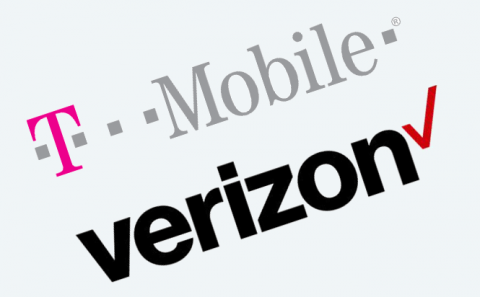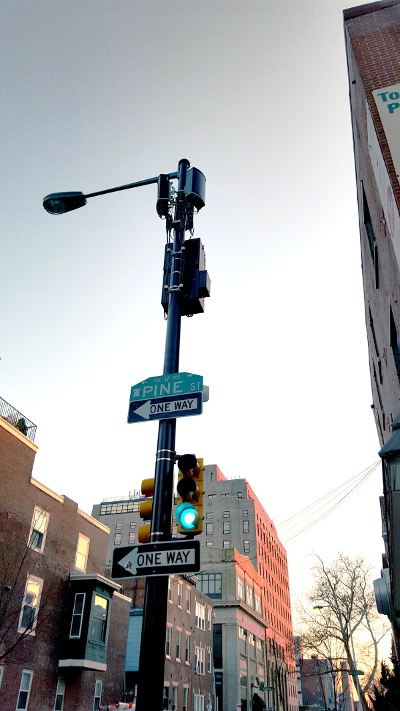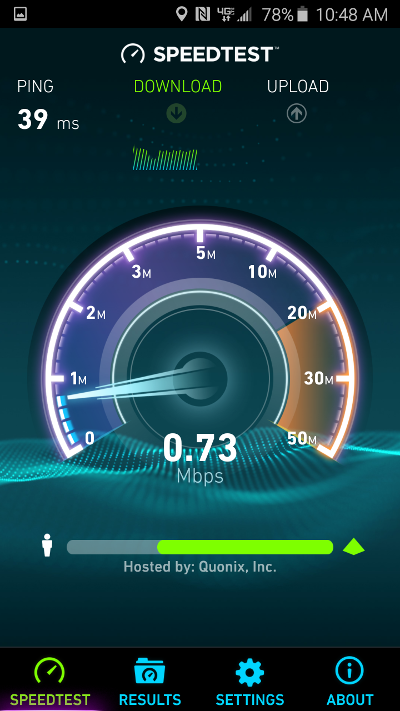
Switching carriers has never been more enticing with T-Mobile and Verizon offering to pay out your contract or device installment plan for switching to their service. This review is going to highlight what to expect in the greater Philadelphia area if you are debating on switching to either T-Mobile or Verizon in the first quarter of 2016. I tend to switch carriers every six months since I enjoy testing network enhancements and new features, so you will see more of these reviews in the future. I will stick to the quick and important aspects of each network.

An ODAS setup on a light pole at 19th and Pine Street in Philadelphia, PA. I confirmed Verizon is one of the carriers leasing this equipment. These installations can usually host multiple carriers and support a radius of ~4 blocks in urban environments. This unit will offload traffic from the closest macro cell site, which serves more subscribers, but can suffer from congestion.
T-Mobile
Pros:
- Offers fastest download speeds. I typically see speeds in excess of 25-35 Mbps (download) and 17 Mbps (upload) in Philadelphia. T-Mobile has deployed wide-band LTE, which provides more bandwidth to its cell sites.
- Fallback to HSPA+ when LTE is unavailable or the signal is blocked by terrain and/or building materials. HSPA+ will display as "4G" on a device status bar and you will typically see average speeds in the mid-teens for downloads, slightly less for uploads. For comparison, Verizon will fall back to 3G, which will struggle to provide 1-2 Mbps in today's environment.
- 700 MHz LTE Band 12 - Newer T-Mobile devices support this recently deployed band, which is a lower frequency than their primary network configuration. This band penetrates buildings better and has less attenuation over distances, allowing coverage to become comparable to Verizon/AT&T. However, this is only in areas where T-Mobile has FCC clearance to deploy it. See this interactive map on Tmonews.com of 700 MHz deployment.
- Low latency LTE - The handshake to deliver data between your device and a server is unmatched in Philadelphia on T-Mobile. Latency averaged less than 20 ms, which is stellar for a cellular connection (home broadband is usually 15 ms or less). A low latency connection means Facebook/Instagram images on your phone will be snappy to load.
- Voice Quality - Even on devices without HD Voice support, T-Mobile's technology allows for higher quality voice codecs, which sound less distorted than Verizon (and other carriers).
- Feature benefits - T-Mobile lets you stream Pandora and other audio services without using data. Their new BingeOn service allows for video streaming without using data; this is accomplished using a special codec that reduces the data packet size transmitted over the network.
Cons:
- Those lacking a Band 12 device and/or are not in a band 12 coverage area will see a reduction in signal when entering buildings with steel/concrete/stone materials (especially in suburbs). This is something folks on AT&T and Verizon take for granted because their lower frequency signals penetrate further. However, T-Mobile's network tends to be more dense in urban areas and this is a non-issue in Philadelphia.
- Rural coverage - Given T-Mobile's legacy of higher-frequency bands, it would cost too much for them to deploy contiguous coverage in rural areas. However, this is changing quickly with the 700 MHz rollout, but you should not expect reliable data while traveling between smaller towns in non-700 MHz areas.
Verizon Wireless

A speedtest.net test on my Samsung Galaxy S6 while connected to a non-XLTE tower in south Philadelphia. Typically, I experience less than 0.5Mbps on downloads. These speeds are unacceptable for an LTE connection in a city, especially since I can replicate this during non-peak hours/events. I am not sure why Verizon engineers have not upgraded this site to use the AWS spectrum.
Pros:
- All new devices support enhanced call quality using Voice over LTE (VoLTE) and/or HD Voice by running over the LTE data network as opposed to the legacy CDMA circuit-switched system. Talk to someone while on a Verizon 3G connection and then try an HD Voice connection -- you will be impressed! The person will sound as if they are standing next to you talking.
- Ubiquitous LTE coverage - Solid LTE connectivity in both the city, suburbs, and rural areas of Pennsylvania (and nationally).
- Verizon has deployed ODAS (outdoor distributed antenna systems) throughout Philadelphia and on the Ben Franklin Parkway ahead the Pope Francis visit. ODAS works great when you have crowds of people in a confined space; the system slices the coverage into smaller chunks that the infrastructure can handle.
Cons:
- Network Congestion - Verizon is working to deploy small cells to augment its network, but they still have issues in Philadelphia with barely usable speeds in some locations. Their network has less dense cell tower placement since they have provisioned LTE on lower frequency bands; this was efficient at first, but now the system is stressed by data-hungry users and applications. You may have seen XLTE branding, which indicates Verizon is using high-frequency AWS spectrum with more bandwidth. XLTE works in addition to their low band frequencies, giving a wider pipe for data to flow. At my apartment in Philadelphia (just south of center city) I average 0.5 Mbps (usually less) for downloads because my phone prefers connecting to a nearby 700 MHz band 2 tower (non-XLTE). However, when I walk North a few blocks I connect to an XLTE tower averaging 20 Mbps down over LTE.
Conclusion: Both networks provide comparable service if you are in/around Philadelphia, with the edge going to T-Mobile for its low latency and impressive speeds. T-Mobile's new band 12 deployment will bring it on par with Verizon's coverage (where available). However, if you are a road warrior and travel to areas that tend to be rural, you may want to stick with Verizon.